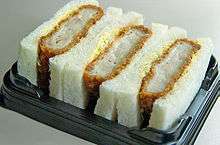Karashi
Karashi (芥子, 辛子, からし, or カラシ) is a type of mustard used as a condiment or as a seasoning in Japanese cuisine. Karashi is made from the crushed seeds of Brassica juncea and is usually sold in either powder or paste form. Karashi in powder form is prepared by mixing with lukewarm water to a paste and leaving it covered for a few minutes.[1]

Karashi is often served with tonkatsu, oden, nattō, and shumai.[2] It can be used as part of a dipping sauce when mixed with mayonnaise, called karashi mayonnaise or with vinegar and miso, called karashi su miso.[3]
It is also used to make pickled Japanese eggplant, called karashi-nasu.[4]
One of Kumamoto's best-known meibutsu is karashi renkon: lotus root stuffed with karashi-flavoured miso, deep fried, and served in slices.
Gallery
Karashi served with various dishes. It is considerably stronger than American or French mustard, so a small amount is enough.
.jpg) Tonkatsu with Karashi (most right, under lemon)
Tonkatsu with Karashi (most right, under lemon) Cutlet sandwich with Karashi-Butter spread.
Cutlet sandwich with Karashi-Butter spread. Oden with Karashi (bottom left)
Oden with Karashi (bottom left) Shumai lunchbox with Karashi (upper left)
Shumai lunchbox with Karashi (upper left) Karashi Renkon, a lotus root stuffed with Karashi-miso.
Karashi Renkon, a lotus root stuffed with Karashi-miso.
References
- Tsuji, Shizuo; Hata, Kōichirō (1986). Practical Japanese cooking: easy and elegant. Kodansha International. p. 145. ISBN 0-87011-762-9.
- Uwajimaya Glossary Archived 2011-07-26 at the Wayback Machine
- Shurtleff, William; Aoyagi, Akiko (1998). The book of tofu: protein source of the future-- now!. Ten Speed Press. p. 46. ISBN 1-58008-013-8.
- Reid, Libby (August 2008). TSUKEMONO: A Look at Japanese Pickling Techniques (PDF). Kanagawa International Foundation. p. 19. Archived from the original (PDF) on 2010-11-24. Retrieved 2010-03-27.